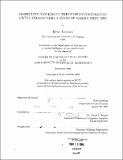| dc.contributor.advisor | David L. Zeltzer. | en_US |
| dc.contributor.author | Lowther, Kyra | en_US |
| dc.contributor.other | Massachusetts Institute of Technology. Dept. of Architecture. | en_US |
| dc.date.accessioned | 2013-01-07T21:09:59Z | |
| dc.date.available | 2013-01-07T21:09:59Z | |
| dc.date.copyright | 1985 | en_US |
| dc.date.issued | 1985 | en_US |
| dc.identifier.uri | http://hdl.handle.net/1721.1/75970 | |
| dc.description | Thesis (M.S.V.S.)--Massachusetts Institute of Technology, Dept. of Architecture, 1985. | en_US |
| dc.description | MICROFICHE COPY AVAILABLE IN ARCHIVES AND ROTCH. | en_US |
| dc.description | Includes bibliographical references (leaves 57-60). | en_US |
| dc.description.abstract | An interactive three-dimensional computer animation system has been developed. The system consists of several graphical editors for creating and controlling articulated (jointed) figures and environments. The primary input device is a mouse, which the animator uses for drawing and choosing menu options. The editors are designed to allow the animator to create specialized drawings describing the subjects of the animation. Modelling data is generated automatically from the drawings. Movement can be controlled in a variety of ways. The animator can position each limb of the figure individually. use pre-programmed skills. or use implemented robotics algorithms. A path planning algorithm is available so characters can find a collision-free path when instructed to walk from one place to another. This is a first step towards goal-directed animation where animators will specify desired goals in terms such as "walk to the door and open it" and characters will know enough about "where they are" and how they can move to perform the appropriate motions. | en_US |
| dc.description.statementofresponsibility | by Kyra Lowther. | en_US |
| dc.format.extent | 60 leaves | en_US |
| dc.language.iso | eng | en_US |
| dc.publisher | Massachusetts Institute of Technology | en_US |
| dc.rights | M.I.T. theses are protected by
copyright. They may be viewed from this source for any purpose, but
reproduction or distribution in any format is prohibited without written
permission. See provided URL for inquiries about permission. | en_US |
| dc.rights.uri | http://dspace.mit.edu/handle/1721.1/7582 | en_US |
| dc.subject | Architecture. | en_US |
| dc.title | Modelling movement through environments : giving characters a sense of where they are | en_US |
| dc.title.alternative | Giving characters a sense of where they are | en_US |
| dc.type | Thesis | en_US |
| dc.description.degree | M.S.V.S. | en_US |
| dc.contributor.department | Massachusetts Institute of Technology. Department of Architecture | |
| dc.identifier.oclc | 14137304 | en_US |
